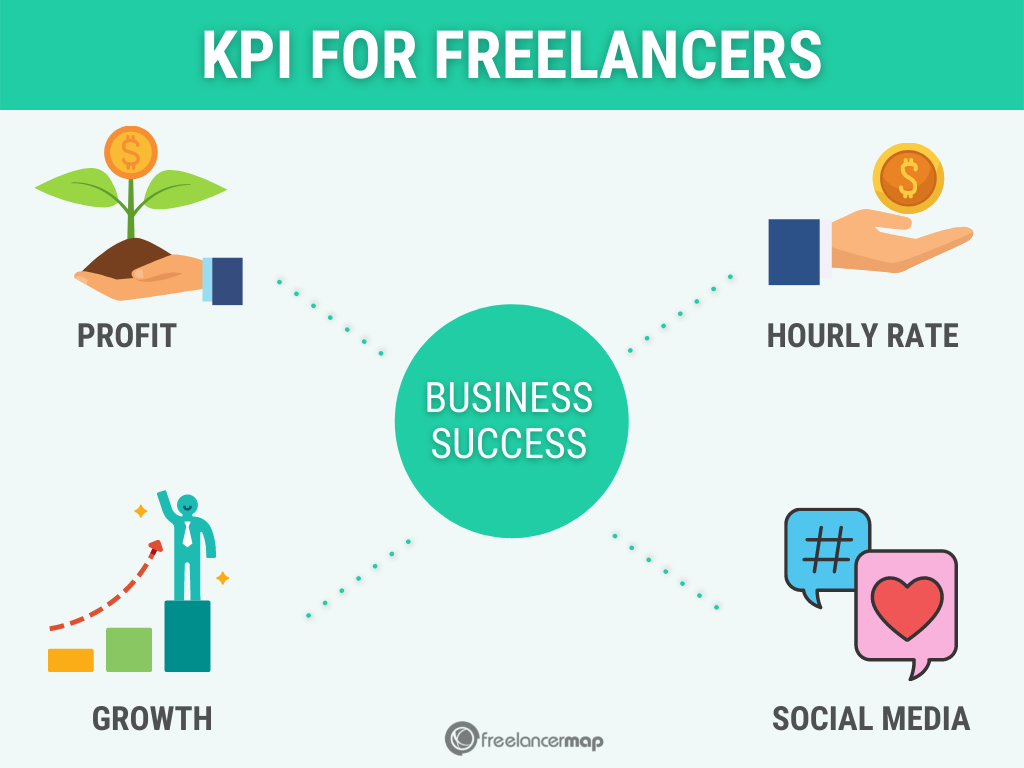KPI or Key performance indicators are defined as a way to measure the performance of a process or a business. In this article, we’re going to take a closer look at specific KPIs for freelancers and how best to utilize them.
- KPI for Freelancers: 4 Ways to Measure Your Growth
- Types of KPIs
- Which Key Performance Indicators Should I Use to Track Growth?
- Measuring KPI using Excel
- Conclusion
There are many ways you can measure success as a freelancer. How much money you’re getting is one, but it isn’t necessarily the most important.
Other aspects you might want to keep track of can include:
- How many clients you’re getting
- What you’re really earning per hour
- Effectiveness of your marketing efforts
If you want your business to do well, “going with the flow” isn’t really going to cut it. You’ll need to define smart indicators to really monitor success.
Continue reading to learn more about what KPI indicators are, with examples of Excel Dashboards. If you have already searched for “KPI meaning” you know that this acronym can represent parameters as different as:
- the number of customers you managed to acquire,
- what you are truly earning per hour of work,
- the effectiveness of your promotion efforts, etc.
So what is a KPI really? The definition of a KPI or Key performance indicator is simple: the way to measure performance of a process or a business.
Using key performance indicators (KPIs) is an excellent way to effectively measure your business development. KPIs are essentially ways to keep track of both long- and short-term developments, allowing you to intervene if a certain area isn’t living up to expectations. It will help you see whether you’re spending too much time on something that’s not worth it.
KPIs are great to effectively measure your business development as a freelancer.
KPIs are defined by the SMART technique. These need to be Specific, Measurable, Achievable, Relevant, and Timely, as this is the only way you can measure its evolution.
KPI for Freelancers: 4 Ways to Measure Your Growth


Profit
Profit is an obvious indicator of how well your business is performing. However, profit can be very different from your total revenue. Profit is the money that goes directly into your pocket, after taxes and business expenses. Consistently measuring your profit can do several things for your business.
For one, it helps you identify so-called “famine periods”, the months when you tend to have less work and get less money. Additionally, it’s a good indicator of how your business is developing over time.
If you have difficulty tracking your income on a monthly or yearly basis, you might want to consider using a financial app or software to make tracking this KPI far easier.
Growth
To really know how well you’re doing in the long-term, you want to measure growth. You can measure that by dividing profits on a monthly or yearly basis. Once you know how much (or how little) your business has grown over the year, you can decide what you want to do with that information.
If you’re looking for increased growth, try to keep it in an upwards year-over-year trend (monthly values tend to be too skewed to be useful in this case).
Maybe you’re happy with how things are going and would like to keep them that way – you should still measure growth and try keeping it in a flat line or slightly upwards to account for inflation and changing expenses. Not doing so might lead to negative growth being ignored until it’s too late to do something about it.
Hourly Rate per Client
Regardless of whether you are charging clients by the hour, by parts of projects, or a complete project fee, measuring the hourly rate is a good idea.
Doing so is relatively simple – track the time you spend on something, add up the hours when you’re finished, and divide your profit by those hours. Across different clients, you’re probably going to end up with a decently large range of hourly rates.
On the top of that range are clients that pay you the most for your time and services. On the bottom, every freelancer will invariably have those clients who take up a lot of your time but don’t contribute that much to your business financially.
Ideally, you want to exchange the kinds of clients on the bottom for the kinds of clients on the top. Once a certain amount of time passes, say one or two years, rinse and repeat for a steady increase in hourly rate and, consequently, profit.
Social Media
Last but not least, by using the previous and additional metrics you can see what your social media marketing is really doing for you. If you’re using Facebook for getting more clients, how many clients does this method really bring your way? Compare that, for example, to how much you get using freelancing websites.
Additionally, what kinds of clients do you get through that particular channel? If they’re always on the bottom of the hourly rate per client scale, you might want to reevaluate your strategy or give up this particular aspect altogether.
A few key performance indicator examples you could evaluate regarding your social media marketing include:
- Traffic to your website via your social media campaigns
- Spend-per click (if you are running ads)
- Follower growth
- Engagement (how many of your followers interact with your posts?)
- Direct messages received from potential leads
However, we emphasize the importance of looking at social network KPI indicators in a more thoughtful way. You may be tempted to over-value certain parameters that are not as important.
Some of these parameters are included in what is known as “Vanity KPIs”. For example, the number of followers, or the number of likes, fits this parameter. This data is much less important than the number of leads generated, or even the traffic generated. However, many people value these parameters too much.
Types of KPIs
The above is just a list of some of the ways you could track the growth of your business using key performance indicators. In reality, there are a huge number of factors that can help you effectively measure and evaluate your growth.
Other types of KPIs include:
- Customer acquisition costs (i.e. how much you’ve spent on advertising measure against how many customers you have acquired with these methods)
- Funnel drop-off rate (how many potential leads leave your website’s sales funnel without converting)
- Inventory turnover (this only applies if you sell physical products as a freelancer)
- Marketing outside of social media (SEO, PPC, etc)
- Leads generated/converted into clients
- The average number of hours on onboarding clients
Which Key Performance Indicators Should I Use to Track Growth?
Deciding which of these KPI examples you want to use to track the growth of your business is entirely dependent on your goal.
Of course, from a business perspective, it makes the most sense to track your financial growth via your profits, cash flow, and hourly rates. So you should focus on financial KPIs.
However, once you reach a point where financial growth is not a key priority, you may decide that tracking things such as efficiency (time over money), customer satisfaction, and conversions are a better way to track the success of your business over time.
Avoiding Vanity Metrics
As we mentioned earlier, there are some KPI indicators that are included in the vanity metrics and that should not be analyzed or pursued too vigorously.
When we talk about vanity metrics we are referring to metrics that can make a good impression, but that do not contribute effectively to perceiving the real performance of a business, nor do they help in defining future strategies.
In fact, any metric can become a vanity metric. For example, a site can have 5,000 registered users, but if only 50 are actually active users, then the total number of users is just a number that doesn’t say much regarding the actual performance.
In this sense, as a freelancer, it is important that you have the ability to distinguish the metrics that really matter, and that can help shape a future strategy.
Haven’t joined our IT freelancer network yet? 2022 is the year!
> Sign up for free
Measuring KPI using Excel
One of the most popular ways to follow KPI indicators is to use Excel files. You can find dozens of templates online by searching for the terms KPI Excel.
However, to make your life easier, we have prepared an Excel Dashboard that we believe can be useful to many freelancers.
You can find our KPI Excel or Excel Dashboard (as you prefer) below:
Download KPI Excel for freelancers
Click on the image below to download a KPI Excel model for project management.
In Conclusion: Understanding KPI indicators is a fundamental step
To sum it all up, KPIs can help you determine what’s going right or wrong with your business and act upon that data. Every freelancer does this subconsciously, but crunching the numbers will give you a crystal-clear perspective, without excuses and rose-colored glasses.
Have you used KPIs and if so, which ones? Tell us in the comments!

